How to use white wood stain. Wood stains, colors from white to colored, methods of correct application
Wood staining - effective method finishes to highlight its beauty and give the material the desired shade. Wood stains (stains), unlike paints, do not form an opaque layer on the surface of the wood, but penetrate into it (as if fused). In this way, nondescript furniture made of cheap wood species can be given a noble look.
What should you look for when choosing a stain?
The chosen one - oak, ash, walnut, etc.) may not look the same from different companies. Therefore, you should trust the visual impression, not the inscription on the packaging.
It should be borne in mind that manufacturers, as a rule, provide color samples on planks of inexpensive wood (for example, pine), and in a finished product made of a different material, the treated surface will look completely different. This is due to the fact that different types of wood have different densities and structures. They also differ in chemical composition elements. When applying the same stain, mahogany will look more almost unchanged in color (this is a very dense material), and poplar and oak will darken. At the same time, the porous poplar will change color very quickly (it absorbs a lot of stain), and a distinct wood pattern will appear on the oak, because it has a pronounced structure.
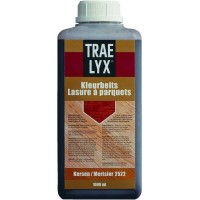
In addition to the type of wood, the result will depend on the quality of the item. Therefore, it is imperative to test the stain on the invisible areas of all materials used before processing.
Stained solid pieces of wood will appear darker than plywood of the same type of wood. This must be taken into account during production. combined furniture... Often, this problem can be dealt with by applying additional layers of dye in certain places.
What are the varieties of Beytsy?
Wood stains, like paints, are divided, depending on the purpose, into two types: for indoor and outdoor use. The latter include in their composition a pigment that does not fade under the influence of UV radiation.
On sale there are pasty (gels), powdery stains and stains in the form of ready-made solutions.
According to their composition, they can be: water, acrylic, alcohol, oil, chemical, wax.
Water stain for wood: advantages and disadvantages
In rooms, it is most often necessary to use a dye without a pungent odor. In such cases, stains are used on water based... In addition, these compositions are advisable to use when painting products with which food or children may come into contact.
Benefits of water stains:
No smell;
- harmlessness to human health when working with them;
- savings (no need to purchase a solvent).
Disadvantages:
Relatively low color intensity;
- long drying time (about 12-14 hours);
- raising the pile on the wood after using the stain. After the dye has dried, the surface must be sanded.
Acrylic stains: price differences

The modern variety of water stains - acrylic stains... They are emulsions based on These formulations have a wider color palette(compared to common water stains) and more resistant to fading. The only drawback that acrylic wood stain has is the price. If a water-based stain in a 500 ml plastic bottle can be bought at a price of 12 rubles (on average, about 50 rubles), then the minimum cost of an acrylic analogue is 310 rubles. Water stain in a barrel of 200 liters costs 4800 rubles, and non-water stain ("Euro bucket" with a volume of 20 liters) - 1710 rubles.
The nuances of staining
1. Material from conifers wood, such as spruce or pine, must first be degummed, because the resinous layers poorly absorb the dye and hardly change their color.
2. It is recommended to moisten the surface before applying the water stain, as wet wood absorbs the dye better.
3. Wood stains in different ways penetrate deep into the material along and across the fibers. Longitudinal dye application is often used.
4. For toning wood, spray guns, brushes, rollers, tampons made of fabric or foam rubber are used.
 5. The dye tends to settle quickly. Therefore, when painting large areas, it is necessary to have in a separate container as much solution as is enough for the entire surface, while the composition must be frequently stirred during operation.
5. The dye tends to settle quickly. Therefore, when painting large areas, it is necessary to have in a separate container as much solution as is enough for the entire surface, while the composition must be frequently stirred during operation.
6. If a powdery stain is used, it must be dissolved in soft water, preferably distilled water (according to the instructions on the package). Hard water can be softened by boiling or adding 1 teaspoon of baking soda to 1 to 2 liters of liquid.
7. To obtain a darker color, use a solution with a higher concentration.
8. If the coloring composition turns out to be cloudy, it should be filtered with filter paper, cotton wool or thick fabric.
9. Before staining, the surface to be painted should be carefully sanded and cleaned: remove oil stains with gasoline or another solvent, hot water, dust - with a brush or cloth.
10. Drops should be avoided, because then they are not easy to get rid of. The dried layer of wood stain is very resistant, and you can completely remove it from the wood only by sanding the surface with sandpaper.
11. When processing vertical planes, the coloring composition should be applied with an upward movement.
12. If the stain is heated before use, it will penetrate deeper into the wood.
13. To achieve the desired result, the stain can not only be applied directly to the surface, but also be added to varnishes, primers and the like.
Staining and How to Avoid Staining
This problem is related to the unevenness of the density of the tree. For certain types of wood (eg walnut and mahogany), staining can be attractive. But in most cases, spontaneously formed stains spoil the product. This defect can be avoided by using a special conditioner, a layer of which will close the pores and prevent the stain from penetrating deep into the material. After treatment with the conditioner, you should use a coloring gel that has the ability not to spread, but to lie down in an even layer.
 To obtain the desired shade of stains different color from the same manufacturer can be mixed with each other. In addition, you can change the tone if a different wood stain is applied to the painted wood, the price of which may differ from the price of the stain used when processing the first layer. Thus, you can save on the purchase of a second expensive pack of dye and expand the range of shades for toning wood.
To obtain the desired shade of stains different color from the same manufacturer can be mixed with each other. In addition, you can change the tone if a different wood stain is applied to the painted wood, the price of which may differ from the price of the stain used when processing the first layer. Thus, you can save on the purchase of a second expensive pack of dye and expand the range of shades for toning wood.
Recently, it has become fashionable to use white in the interior of the premises.
At the same time, white can be both on surfaces (floor, ceiling, walls) and on furniture. The interior with a predominance of white is really very impressive, and it is not at all difficult to execute it in this style.
White stain is one of the means of making the surface white. You can buy a white stain without any problems in almost any hardware store... We will talk about white stain in this article.
First of all, you need to decide where exactly the wood will be processed - indoors or outdoors. Techniques for processing external and internal surfaces are different, therefore this point is of fundamental importance. Let's talk about how you can bleach wood.
How to bleach wood
 If the surface to be treated is part of the interior, then the desired white color may not be just white, but with decorative elements. For example, wood fibers you can leave it with a natural shade or any other of your choice, and make the pores of the wood white. The choice of wood stains and products for different options the effects are very large. For the above example, the wood can be tinted with a water stain, such as Trae Lyx or CLOU, and then treated with an oil containing Trae Lyx Pro color Wit. The pores of the wood will be white, and the fibers will have the color of the selected stain.
If the surface to be treated is part of the interior, then the desired white color may not be just white, but with decorative elements. For example, wood fibers you can leave it with a natural shade or any other of your choice, and make the pores of the wood white. The choice of wood stains and products for different options the effects are very large. For the above example, the wood can be tinted with a water stain, such as Trae Lyx or CLOU, and then treated with an oil containing Trae Lyx Pro color Wit. The pores of the wood will be white, and the fibers will have the color of the selected stain.
It is necessary to take into account that the pores of the wood must have a distinct woody structure, be open and deep. However, not every wood has such a natural surface. If the wood does not have the required relief, then the surface is treated artificially using special brushes, which remove soft fibers from the surface.
 If you want to paint both the woody surface and the pores white, you can use Trae Lyx Parquet Cleaner No. 2537.
If you want to paint both the woody surface and the pores white, you can use Trae Lyx Parquet Cleaner No. 2537.
Please note that when using water stain, you will definitely need to apply a second coat. The second layer can be varnish or oil, which contains hard wax.
To bleach wood for the interior, you can use white oil, which includes Golden Wave wax. According to the manufacturer, the development of this product is based on Scandinavian recipes dating back hundreds of years, due to which Golden Wave has unique characteristics. The surface should be coated with two or three coats of oil, depending on the desired result - the more coats you put, the higher the whiteness and the lower the visibility of the wood structure. No fixing agents are required when using Golden Wave Oil, this product includes fixing components. However, if you wish to change the color of the wood coating before processing, then treat it with a water stain such as GLOU, the whitening effect will be unique.
Trae Lyx PROJECT SEALER 2K wit can also be used to whiten the surface. It is a special insulating white primer for parquet flooring. But this primer requires an additional protective layer, for this purpose Trae Lyx two-component varnish can be used. This combination is extremely reliable and of high quality. She not only recreates, but also complements natural beauty natural parquet or wooden stairs.
As another option for bleaching natural wood, we can offer the use of Golden Wave white wax. More often they are used to process railings, beams, walls, ceilings and furniture, because these surfaces are not subjected to heavy loads during operation. The base of Golden Wave white wax is turpentine, it is composed of natural Portuguese wax and special pigments. This wax can be used to coat untreated wood and get a wonderful effect with little effort. 
Calcpasta is another tool for bleaching wood surfaces that you should pay attention to. It is used in those cases when they want to get the effect of deep antiquity, the appearance of an ancient and dilapidated tree, whitened from time to time. Of course, the effect will be only external, the strength of the treated surface will remain the same. Use calcpasta to process the most different surfaces, since it is suitable for both indoor and outdoor work. Parquet, stairs, furniture, windows, shutters, doors, houses, gazebos, swings - any wooden surface suitable for processing with calc paste.
Outdoor stain
In addition to the aforementioned calcpaste for whitening external surfaces, it is good protective white wax stain Verfijn Steigerhout beits. Its application emphasizes the naturalness of the natural surface structure. In addition to its remarkable aesthetic effect, this outdoor stain perfectly protects the wood surface from blue and rotting for a fairly long time.
We have already written about how to properly protect wood from fungus, the material is available here, you can familiarize yourself with it if you wish.
Film-forming coatings are also used to bleach wood.
Another bleaching agent is Sigmalife VS-X alkyd-based outdoor stain. This stain, in addition to its direct bleaching functions, serves as a primer and has excellent protective properties, it will protect the wood surface from bad weather and ultraviolet radiation for a long time. For nai better result apply Sigmalife DS acrylic as the last (finishing) layer or AVIS timbercoat varnish, which is also made on an alkyd basis and is of high quality. When using Sigmalife VS-X, the tree will be reliably protected from all aggression the environment, even if the top coat is not applied immediately.
There are many methods and technologies for bleaching wood coatings, and it will probably take a whole book to consider all of them. This article outlines the basic principle of whitening and shows the means by which it is easier to achieve not only the best result, but the one you would prefer. In addition, each of the considered means has its own special characteristic that is not characteristic of others. Knowing these features, you can more easily make your choice for a specific use.
Similar news:

Stains are substances that are designed to treat wood and give it a special appearance... Stains are most commonly known as liquids, but today there are other types that perform similar functions.
What is the stain for?
The main purpose of using these substances is to reveal the inner beauty of wood, which is sometimes hidden deep in it. The colors and shades obtained by the interaction of a substance with wood are so diverse as the photo when wood is treated with wood stain that it is almost impossible to see all these colors together in any interior.
The stain enhances the texture of the wood.
There are several key varieties of wood stains that differ depending on the base. The type of base also predetermines the individual properties of the stain, each of which has its own distinctive feature.
Varieties
The 3 most common groups of stains are identified.
The first group includes the so-called alcohol stains. An alcohol-based substance is a characteristic aniline solution of a certain pigment in denatured alcohol. Typically, such a stain is produced in one of two types: already in liquid, which can be used immediately after purchase, and also in powder form. In the second case, you need to dilute the powder. This stain has characteristics, it dries much faster than others. Therefore, to use it with your own hands, you should only use a spray bottle, since manual application leaves stains. A pneumatic spray gun is usually used as a spray gun.
Water stains are made in the same way as alcohol stains. They are the most popular of these substances. Water stains have the largest range of colors and natural shades of wood for staining. And although water stain is the most common, it still has one significant disadvantage: from its application, the wood fibers rise upward, which makes it sensitive to moisture. On the other hand, there are also positive aspects to this effect, since thanks to the raised fibers, a pronounced internal structure of the tree is manifested. In order to prevent the raising of fibers, use one simple method: before staining, the part or surface is briefly soaked in water, after which it is treated with an abrasive cloth. The wood prepared in this way will not rise after staining with water.

The properties of the stain directly depend on the base on which it is made.
Oil-based stains come in the widest range of colors available to humans. Butter - good solvent for most dyes, due to which this effect is achieved. Oil formulations are diluted with white spirit, which also helps it dry quickly enough, but at the same time it does not cause negative consequences:
- The oil ensures even application.
- The wood fibers remain in the same position.
Acrylic and wax types of wood stains, which are not yet so popular, are also determined quite young in time of appearance. Although they have all the advantages of oil formulations. Their key advantage is education protective film on the surface of processed parts and wood products.
Stain application methods
For different types of wood stains, as well as when processing surfaces of different area and texture, different devices may be required. In most cases of household staining, it is sufficient to use a brush, and in the case of small surfaces, sometimes a foam swab is used.
If the stain is alcohol-based, you can use a spray bottle for use. In fact, the use of alcohol, as well as nitromoil has the only exception in the nature of surface treatment and requires a spray. This is caused, as already mentioned, precisely by the high speed of drying of the compositions. A foam swab or brush does not provide an even coverage for alcohol stains, leaving stains on any surface.
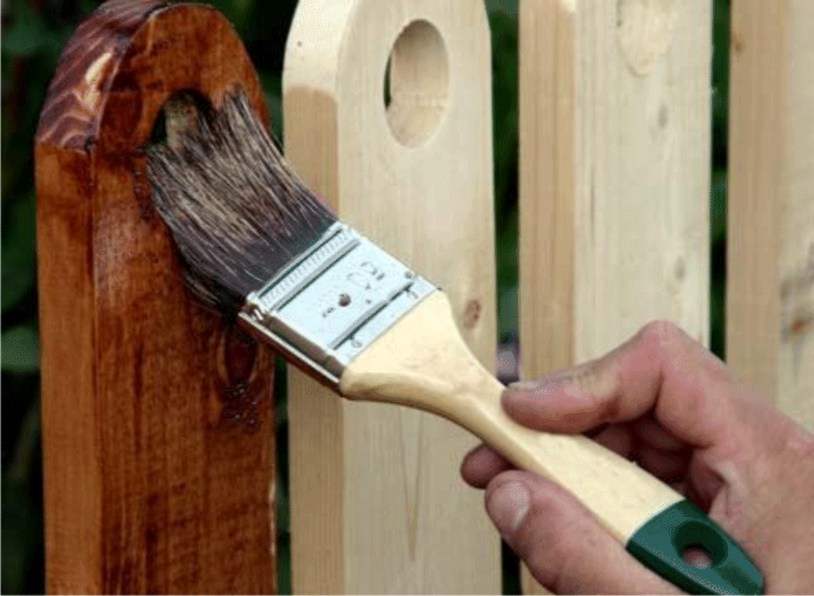
The stain can be applied with a brush, foam sponge, spray.
General recommendations for using wood stains are to use the optimal tools for large areas and for small ones.
When applying the composition to the surface, it is often necessary to devote a long time to the process of achieving the desired color.
Experienced craftsmen advise to treat the surface twice, while after the first coating it is very important to wait until it is completely dry and only then apply the second layer.
This may resemble the principle of finishing wood with varnish or tinting wood.
In the case of aqueous formulations that do not dry as quickly as alcoholic ones, the requirements for complete drying are even more important.
Coloring technique
Craftsmen and experimenters for many years, using different compositions and combining colors, have learned to cover with multi-colored layers different types tree, which allows you to get rather unexpected results. Double application often different colors allows you to get a fairly clear and expressive structure of the tree, or vice versa, all the signs of prolonged aging.
Thus, for example, the effect of "bleached oak" is achieved, which is also done with the help of two different types diy staining liquids.
The first type of stain for bleached oak is a white wood stain with an aqueous liquid. After the surface of the wood is completely dry, it is treated with a second layer of the so-called oil stain... This second compound, a colored wood stain, contains particles of colored wax. Thanks to the colored particles, individual pores acquire the desired color (usually shades of gray or black), while, in addition to the pores, the rest of the surface has the same appearance, which remained after the white water stain. Thus, the wood gets an aesthetically pleasing finish, thanks to repeated processing.
This is one of so many ways to stain wood, which allows you to get completely different effects. When using a mixed technique, the main thing is not to confuse the order of using liquids.
It is better to use water or alcohol bases at first, and the final results are achieved with oil and wax compounds.
This is because wax and oil formulations do not allow other substances to penetrate into the wood, as this is obtained by processing with alcohol and water.
It is also interesting that the processing of different types of wood, like most resinous species, does not lend itself to staining, since it is difficult for colored particles to get inside the wood after that. But deciduous trees with such processing absorb almost any stain.
In addition, the quality of the resulting picture can be influenced by the internal structure of the tree itself. Therefore, such vivid pictures and drawings are often obtained precisely thanks to the use of oak or, for example, exotic species.
Video: how to choose a stain
At the dacha and in a private house, wood is actively used: floors, windows, doors, furniture, gazebos and decor elements. And no matter how beautiful the tree is in its natural form, under the influence of time and external factors it quickly loses its attractiveness and consumer qualities: under the influence of the sun it dims and turns gray; moisture can deform; when bacteria multiply - rot. Therefore, if you want to keep the structure and a decent look wooden products for a long time, then they should be treated with stain.
Stain (also called "stain") is a special liquid composition to give the wood the desired color (toning). Usually these are colors that imitate noble wood species. But multicolored toning is also possible in accordance with the designer's idea.
The main difference between stains and paints and enamels is that the tinting impregnation elements penetrate deep into the wood and paint it from the inside, while retaining the visible texture and grain pattern. However, an opaque film does not form on the surface of the part, as is the case with paint treatment.
In addition to the aesthetic function of giving the tree a noble and attractive appearance, the stain also performs a number of practical tasks:
- protection of wood from moisture;
- protection against the destructive effects of ultraviolet radiation;
- prevention of the growth of bacteria that destroy the tree.
As a result of using wood stain, the service life of wooden parts can be extended several times.
Types of stains by composition

Manufacturers produce wood stains that differ in their base. Choose the composition suitable for your case, based on what result and in what time frame you need to get. Each lineup has its own pros and cons.
Water-based stain. In specialized stores, you can purchase such a stain in the form of a ready-to-use liquid or powder, which you will need to dissolve in warm water before processing the wood. The final color intensity of the coating will depend on the ratio of the amount of powder and water. Before applying water stain it is necessary to strain so that undissolved particles of the dye do not get on the wood.
A big plus of water-based impregnation is the absence of a pungent odor. This makes it suitable for indoor use. The water-based tinting liquid perfectly emphasizes the natural grain of the wood: it highlights some fibers and hides others. For complete drying, the composition will take 12-14 hours. But as for the disadvantages of water stain - it tends to lift wood fibers, because of this, after drying, the tree turns out to be rough and less protected from moisture. To cope with the problem you need:
- or to sand the already treated surface after the composition has dried;
- or moisten the surface with plain water, let the water soak in, when the fibers rise, sand the wood, and only then cover it with stain.
Alcohol-based or solvent-based stain (nitromorilac). From the name it becomes clear that this type of impregnation is based on alcohol (denatured alcohol) or a special solvent. Just like the previous version of the stain (water-based), it is produced in the form of a ready-made composition or powder that will need to be dissolved. After distributing the stain, the coloring matter is quickly absorbed, and the alcohol / solvent evaporates, so the time for complete drying of alcohol impregnation is only 20-30 minutes. The technology of applying such a stain is also associated with fast drying: it must be applied quickly and evenly in order to avoid the appearance of spots and irregularities on the finished product. It is most convenient to apply alcohol and nitro stain using a special sprayer rather than manually.
Stain on oil based... The dye in such an impregnation is dissolved in special oils (most often it is linseed oil). It is thanks to the base that this type of product is the most environmentally friendly (i.e. it does not emit any harmful substances), therefore it can undoubtedly be used to process furniture parts, even such as parts kitchen furniture and furniture for the children's room. This is the most popular type of stain among furniture makers:
- it dries quite quickly - in 2-3 hours;
- deeply impregnates wood;
- does not lift wood fibers, so the material is reliably protected from moisture penetration;
- applied evenly without much effort;
- the color of the treated surface does not fade for many years.
Acrylic stains are produced on a water basis, which, thanks to a diverse palette, allow you to reproduce any desired shade of color. This is a new generation of impregnations, in which the disadvantages of the usual types of impregnation are eliminated. But today such impregnation is the most expensive.
- acrylic stain dries very quickly;
- has no smell;
- does not emit toxic fumes;
- the color is very stable (it lasts for many years);
- lays down evenly and does not form stains;
- reliably protects the tree from moisture.
Wax stain is latest technology in the field of wood processing. The substance is a soft waxy mass. Such impregnation does not penetrate into the depth of the wood, but creates on its surface protective layer... It is not recommended to use wax stain as a base for two-component varnishes. The wax composition is rubbed into the surface of the product using a soft cloth. When applied, the appearance of stains and the raising of wood fibers are excluded.
Wood stain: color

The stain not only protects the wood from rapid wear, but also gives it a beautiful noble color. Since the structure of the tree itself is heterogeneous, the dense fibers are impregnated with stain to a lesser extent than others - that is why after the impregnation dries on the products not only remains, but also the natural pattern of the wood stands out better.
Modern impregnations can paint wood in any color, but the most popular is the "woody" range of shades. Each name corresponds to a specific wood species: oak, teak, pine, walnut, mahogany, plum, mahogany, etc. If you could not find suitable color among the ready-made shades, you can mix several tones yourself.
When in a specialized store you will select a color, pay attention, first of all, not to its name or the photo on the package of the stain, but ask the consultant to provide you with samples of wood covered with stain of specific shades.
The fact is that different manufacturers formulations with the same name may have different shades. So that the result of processing parts was not unexpected, carefully examine the samples.
The intensity of the color depends a lot on the type of wood you intend to process: its natural color, density, porosity and texture. So conifers of trees do not absorb stains very well due to the abundance of resins, but deciduous ones, on the contrary, are saturated as much as possible. For example, if you treat maple and mahogany with a stain of the same color, then the color of the latter will be much darker (since the mahogany itself is initially darker). And if details, for example, from maple and pine, are covered with impregnation, then the final color of the maple part will be more intense.
White stain is used to create a trendy bleached wood effect, such as “ bleached oak"Or" arctic oak ". Also, with the help of white stain, you can create products with an antique effect. Then, as the first layer, a white water-based stain is applied, and after it dries, the pores in the wood structure are filled with a dark oil-based or wax-based impregnation.
It should be noted that not all types of wood stain have a pronounced color: there are transparent compounds that are applied exclusively to protect wood from destruction.
Wood stain: how to apply
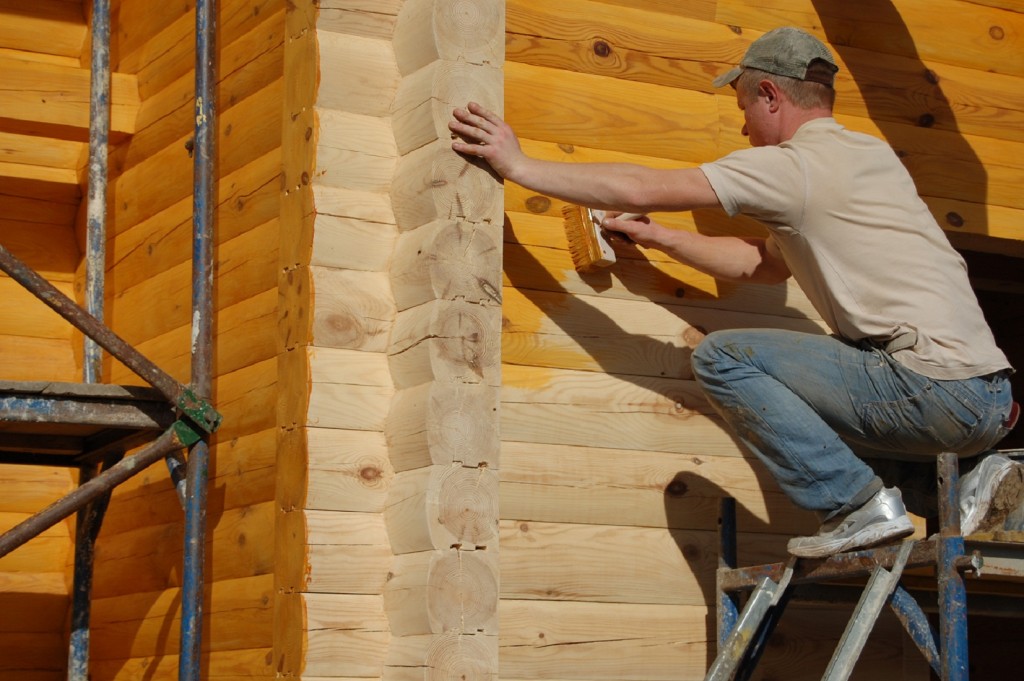
You need to choose the method of applying the stain depending on what type of impregnation you purchased (water, alcohol or oil based), as well as the size of the part and, of course, your convenience.
The stain can be applied with a brush, swab, or paint spray. If you need to treat a large area, then with a brush it will be so convenient to do it: firstly, there will most likely be stains from the brush villi, and secondly, it will take too long.
When the area of the part is large and the water- or alcohol-based stain dries quickly, it is easiest to use a paint sprayer. In this case, choose a stain that is slightly lighter than the desired color. in the process of application, its layer will be thicker. When working with a sprayer, be sure to protect other surfaces with foil.
When applying oil stain, an excellent result is obtained when working with a swab (for its manufacture, take a large piece of foam rubber or cotton wool wrapped in a soft cotton cloth).
If you prefer to work with a brush, then choose a tool with synthetic bristles for aqueous and alcoholic compositions; a brush made of natural bristles is suitable for water, alcohol and nitro stains. Buy quality brushes that won't leave lint on the surface to be treated.
Wood stain: color proof

So, you have chosen the desired color and decided on the coloring tool. Now, to figure out how many coats of impregnation you will need to apply to your wood pieces to get the desired color, make a test paint (do a color test).
- take a small plank of the same type of wood as the main parts for painting;
- sand the surface thoroughly, as you will do with the main details;
- apply the first layer of stain on the entire sample board and let it dry completely;
- then apply a second layer of impregnation, but already on 2/3 of the board;
- when the second layer dries, apply the third one to 1/3 of the sample;
- compare the intensity of the color in each of the cases (one, two and three layers of stain) and choose the optimal one for yourself.
Wood stain: preparing parts for staining

Uncoated wood is treated: either a new board or wooden detail, from which the old coating has been completely removed.
- Absolutely dry wood needs to be leveled and sanded sandpaper(with a sandpaper). Try not to press on the parts and direct the movement only along the grain - this will avoid unnecessary grooves and scratches. The fact is that if the scratches seem insignificant on damp wood, then after processing it with a tinting compound, the defect will be very noticeable. Sanding should continue for about half an hour, during which time the surface will become smooth, and pores will open in the wood for deep penetration impregnation.
- When sanding is complete, use a vacuum cleaner to remove all dust and lint from the part.
- Degrease the surface with benzine or white spirit thinner.
- Moisten the wood slightly with water. Any type of stain will adhere better to a damp surface.
Wood stain: additional processing of conifers
Coniferous wood contains a large number of resins. After staining, the resinous areas of the part may appear as ugly stains. Therefore, before applying the impregnation, it is necessary to de-resin the tree. To do this, use one of the compositions:
- in 1 liter warm water(60 degrees) dissolve 60 g of soda ash and 50 g of potassium carbonate;
- mix 250 g of acetone with 750 ml of water.
After you prepare the mortar, apply it to the boards with a soft cloth or large brush, so that the wood is well drenched. It is preferable to treat the surface 2-3 times with a short break. Then leave the composition to act for half an hour. Clean the parts with warm soapy water. Only after the parts are completely dry from water, you can proceed to their further processing- toning with stain.
Wood stain: instructions for applying
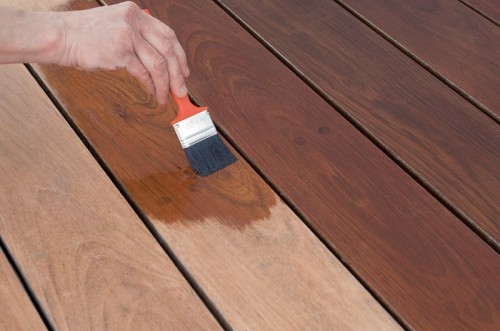
- Shake the can of stain to mix evenly.
- Warm the composition to body temperature. This will help the impregnation substances penetrate deeper into the pores of the wood.
- Lightly soak the tool of your choice (brush, roller, swab) in the stain so that the substance does not flow. If using a spray bottle, pour the tinting compound into a special container.
- If you need to process vertical surface, then it is better to do it from the bottom up. So, if small smudges form, they will be less noticeable and it will be easier to neutralize them.
- To stain a horizontal part, first brush along the grain, then across and again along. This will ensure an even coverage.
- Spread the impregnation carefully and make sure that it lies evenly and not glass.
- However, keep in mind that the wood must be soaked well, and the excess substance (which will not be absorbed) will subsequently be removed.
- Treat quickly and without interruption to avoid stains.
- To obtain the desired color, apply the right amount layers of stain. In this case, before applying the second layer, the first must dry completely.
Wood stain: cleaning

Washing is the final part of wood staining. It is carried out when the impregnating composition is completely dry. The cleaning process removes the excess tinting agent. Which did not absorb the wood. After washing, the part will look completely different: the texture and shine of the treated surface will appear.
For cleaning, you will need a large amount of acetone and a thick volume brush.
- Tilt the part at a slight angle.
- Position the part so that there is some absorbent material (such as paper towels) underneath.
- Soak your brush in acetone.
- “Sweep away” excess stain with a brush from top to bottom, so that it glides with acetone.
- Continue until the part looks uniform.
- When the stain stops coming off, washing is complete.
- Let the parts dry from acetone. And then you can apply the final coat - varnish.
Wood stain. Photo
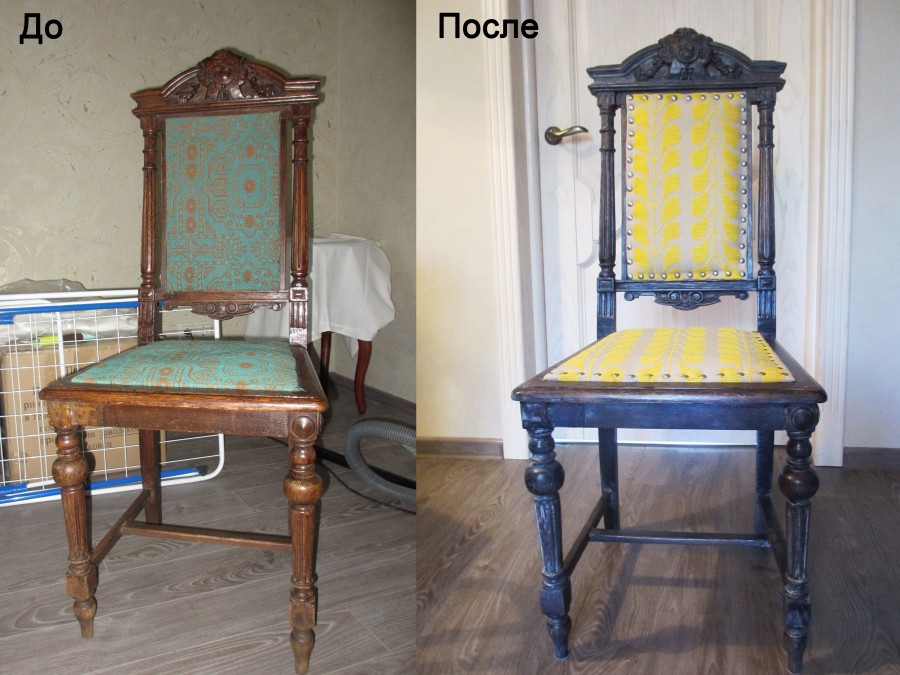



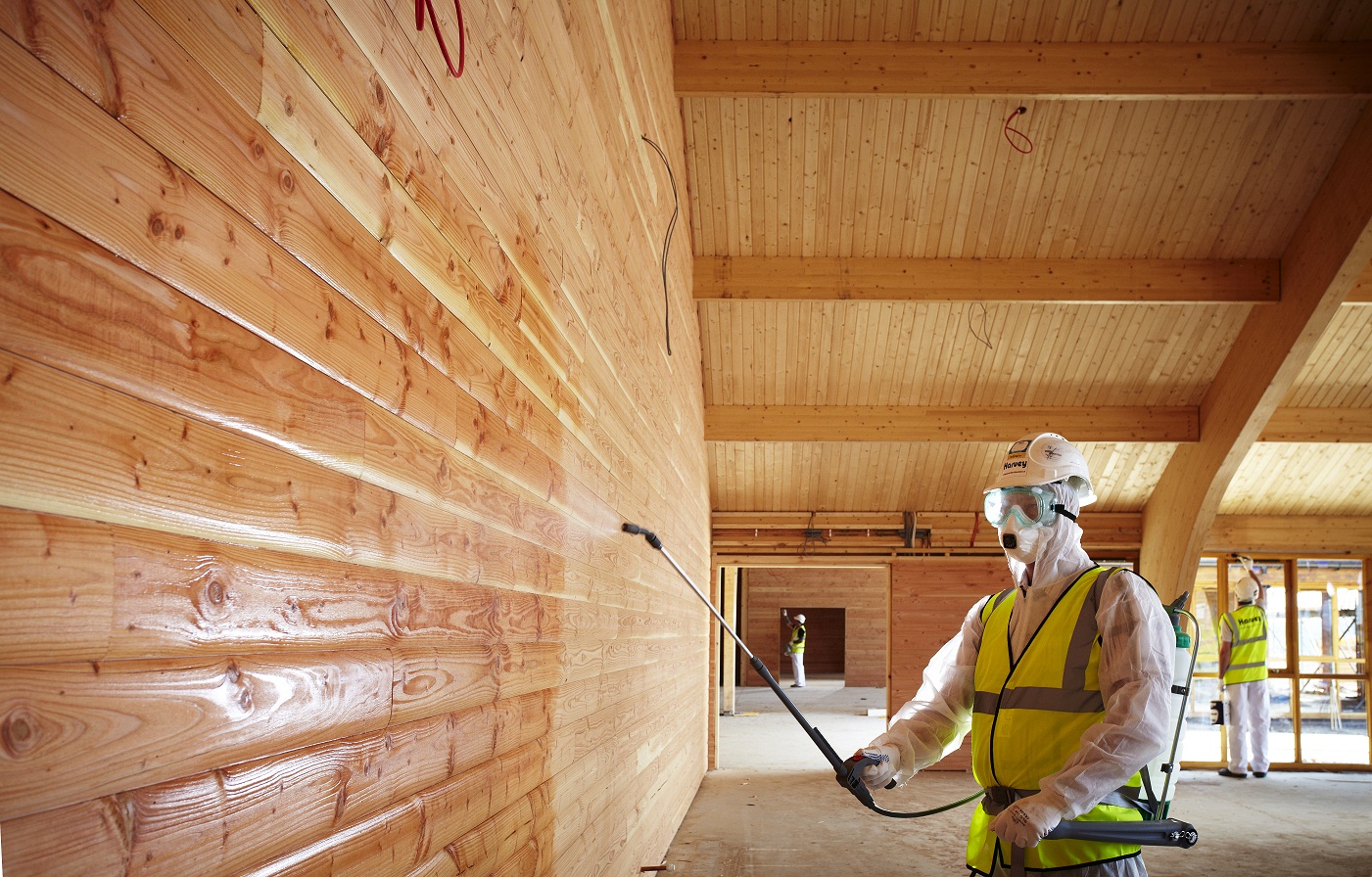

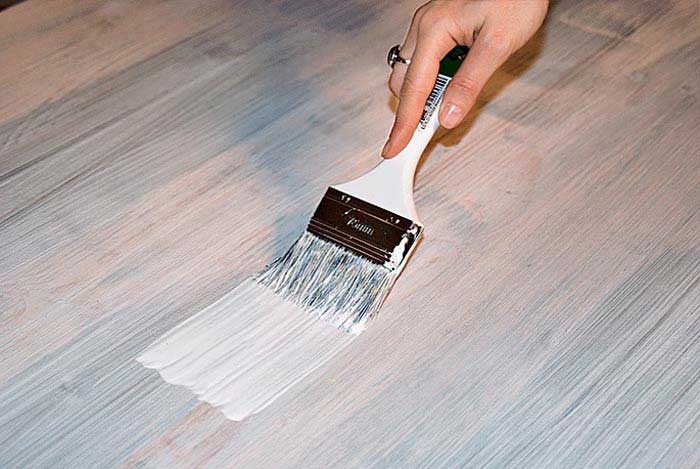
Wood stain. Video
How to use white wood stain on wood?
Modern fashion dictates its own conditions, and one of these conditions is the indispensable use of white in the interior. White can be floors, walls, furniture, ceilings, etc. Looks white interior really impressive, and it is not that difficult to achieve the required degree of whiteness. In particular, one of the main tools for making woody surfaces white is white stain, which you can easily get in your city. We will tell you about this tool.
First, you need to determine whether you will process the indoor surface, or the wood will be used as an outdoor (street) covering. In this case, wood processing will be carried out according to completely different methods, so pay special attention to this moment.
Processing facilities:
If the treated wood coating will be of an interior character, then you should pay attention to the desired effect. The fact is that the choice is wide enough, and to achieve each individual result, you need to use a different means. For example, if you want to make only wood pores white, and solid wood fibers should have a natural shade or even a different color, according to your desire, then you can purchase oil with the addition of wax such as Trae Lyx Pro color Wit for processing. That is, we tint the wood with water stain (Trae Lyx, CLOU or any other), after which we apply the product. Our wood will acquire the color of a stain, and the wood pores will become white.
Consider the fact that the pores in the treated wood surface must be guaranteed to be deep, open, and with a distinct woody relief structure. Not all wood surfaces can boast such natural properties, as a result of which you will have to create a structure with artificial mechanical method... For this, special brushes are suitable, which will rid the surface of soft fibers.
If you want the pores and the woody surface to be white, you can use a white stain such as Trae Lyx # 2537 for parquet. Please note that the use of water stain should provide for the subsequent use of protective coatings, which include varnishes and oils with the addition of hard wax. Protective coatings must be used without fail.
Bleaching of interior wood can be done with a white wax oil such as Golden Wave. According to the manufacturer, this product was developed on the basis of centuries-old Scandinavian recipes, as a result of which it has unique characteristics. The wood product should be covered with 2-3 layers of oil, depending on the required degree of whiteness and the degree of visibility of the wood structure. With regard to the use of the fixing agent, for the white oil with the addition of wax, protection is not required, since the product is finished. Before using Golden Wave oil, you can use CLOU water stain to change the color of the wood surface. This will help achieve the unique bleaching effect of the wood.
You can whiten woody surfaces with Trae Lyx PROJECT SEALER 2K wit. It is a special insulating white primer for parquet flooring, which provides additional use Trae Lyx two-component varnish as protective means... This combination will create a coating of the highest reliability and quality, which will completely recreate and even complement the beauty of a wooden staircase and natural parquet.
Another option for whitening natural wood surfaces is Golden Wave white wax, which is used on handrails, beams, ceilings, walls and furniture. That is, white wax can be used on surfaces that do not experience heavy loads during operation. Golden Wave wax is based on turpentine. It uses natural wax from Portugal, as well as a number of special pigments. By waxing untreated wood, you will be able to quickly create a great effect without wasting unnecessary effort.
Calcpasta is another tool that deserves your attention when you need to bleach wood. The effect of its use is an old and dilapidated tree that has turned white over time. Do not worry, the "old" wood surface will only be external. The reliability of the coating will remain unchanged. Kalkpasta can be used for both indoor and outdoor work. In combination with other bleaching materials, it is used to treat stairs, furniture, parquet, windows, doors, shutters, houses, swings, gazebos and more.
Wood bleaches:
Let's move on to the use of modern wood bleaching agents for outdoor use. In addition to calcpaste, you can use Verfijn Steigerhout beits protective white wax stain. Its application will bring you back to Mother Nature, as it were. White color will easily emphasize the uniqueness of the structure and appearance of natural wood. Along with the aesthetic effect, the stain will perfectly protect the wood from rotting and blue discoloration for a long time. Wood bleaching can also be achieved with film-forming coatings.
If you want to use a primer that acts as a white stain at the same time, then get Sigmalife VS-X, an alkyd-based protective stain. Using this tool, you can protect wood from ultraviolet rays and bad weather for a long time. On top of the Sigmalife VS-X you can topcoat apply Sigmalife DS acrylic (acrylic glaze). In addition, you can use high quality varnish AVIS timbercoat, which also has an alkyd base. By processing wood with Sigmalife VS-X, you guarantee the coating protection from any external factors, even if it will be left without finishing for some time.
Of course, there are still a lot of methods for bleaching wood, and you can list them all for an infinitely long time. But in this article we have described the most effective and effective methods giving the wood flooring a natural white color, which we hope will be of great use to you.







